WORLD CLASS COACHING
Club Curriculum U9/10 Season
By Tony Englund
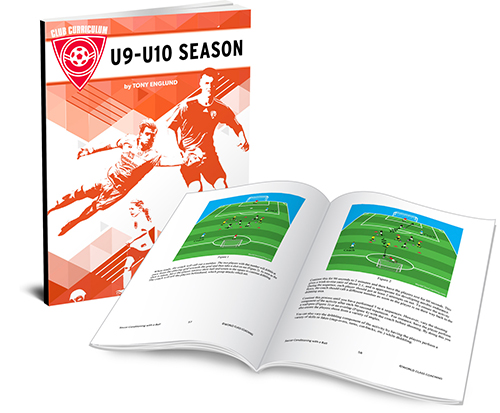
TABLE OF CONTENTS
Part One
INTRODUCTION
SYSTEMS OF PLAY
RESTARTS
Part Two
TECHNICAL SESSIONS
Part Three
TECHNICAL SESSIONS
Part Four
TECHNICAL SESSIONS
ABOUT THE AUTHOR
Introduction: The Golden Age of Soccer Learning
The starting point for any adult planning to mentor young children is to be certain to adopt the proper perspective in developing a philosophy of coaching that reflects a thorough understanding of the differences between adults and children. Simply put, coaching 9-10 year-olds carries a mandate to introduce young people to physical activity, social interaction in the team setting and having fun playing the game of soccer.
Adults must take into account the physical and psychological abilities and needs of young children in planning and also coaching activities for 9 and 10- year olds. Children at these ages have immature and growing skeletal and cardiovascular systems that influence their motor abilities. They have limited agility and often go very hard, become exhausted and stop, and then quickly recover. Psychologically, young children have a fragile and evolving self concept that needs consistent nurturing through social acceptance and adult approval of their efforts (as opposed to results), and though they are intrinsically motivated, they do not have the sense of competition that is present in older children and adults.
In addition to accounting for the physical and psychological needs of young children, coaches must also attempt to understand why children play soccer (or any sport), and try to design the team experience to nurture those motivations. Fun, exercise, being with their friends and skill development are all important considerations for young children in this sense.
There are numerous studies in print outlining the reasons why children quit playing sports (as many as 75% by age 13). Not surprisingly, those reasons mirror the motivational elements that draw children to participate, as not having fun or improving and not being with their friends are among the chief reasons kids stop playing.
The message, then, is a simple, but very important one: Young children have different physical and psychological needs and abilities than adults and the latter must coach to the needs of the former, not to the needs or abilities of a fully mature adult. Children generally play sports for exercise, fun and skill acquisition, not to win, and, as a mentor once explained to the author, “Coaches at this age should judge their success this year not based on wins and losses, but rather on the number of kids who sign up to play again next year.”
Given all of the requisite warnings about the philosophy of coaching the U9 and U10 years, it is also noteworthy that these two years introduce children to competitive soccer, and national coaching organizations the world over agree this period also represents the beginning of what is generally referred to as the ‘Golden Age of Soccer Learning.’ Children at these ages are able to learn mentally and physically at an accelerated pace, and their skills and tactical understanding can be dramatically improved during these critical years through quality training. Therefore, coaches must be well prepared for every training session and focus on both fun and learning.
Best Wishes.
Tony Englund
Organizing a U9-U10 practice session
One of the most important aspects of coaching is preparation. Even at the youngest ages, players and parents will recognize whether a coach has taken the time to organize his or her thoughts and create an effective, coherent practice plan.
Preparation elements:
-practice plan: Which exercises will be used and for how much time? What are the key teaching points? The coach should have a written plan for every session.
-equipment: What types and how many balls, vests, cones, goals, etc. will be needed? Don’t forget a ball pump!
-safety: The coach should walk the practice area before each session, checking for items that could pose a danger to children. In addition, the coach should carry a phone with emergency numbers for all players. The coach or manager should always have a first-aid kit on site. Lastly, the coach should be the first to arrive and the last to leave training, assuring that there is adult supervision of children at play and that no child is left alone at the field. It is recommended that two adults be present at all times.
U9/U10 Practice
Children at these ages are in the midst of acquiring motor and mental skills, and their U9/U10 experience is often their introduction to competitive soccer. Training for coaches in these age groups consistently emphasizes that the primary goal is for children to have fun through a combination of introductory skill learning and lots of fun playing environments.
Training time: Roughly equal to the length of a game, and generally not more than an hour.
Composition: About ½ (usually the final portion of practice) of every training session should be spent just letting children play soccer. The remainder of the time should be built around a variety brief, instructive training and fun games that allow players to practice those skills. It is recommended that the coach choose a theme for each session (i.e. individual attacking, defending or passing and receiving). It is important to remember that at this age, children are ready to change activities fairly quickly and it is important to give them new tasks and challenges every few minutes to keep practice fun and exciting.
Setting Curriculum
This book is designed to provide a full season of training sessions for a competitive U9 or U10 team. While the sessions do not have to be used in order, the order of presentation will provide a coherent practice season for coaches that run the practices in that fashion.
Systems of Play: 1-2-1-2
Teams at these age groups often play with a goalkeeper and five field players. The most common and recommended arrangement of players is 1-2-1-2. This chapter provides an overview of considerations for coaches to implement this system of play. It must be stressed at the outset, however, that tactical considerations at U9 and U10 are secondary to technical development and the idea here is to simply provide a framework for organizing the team.
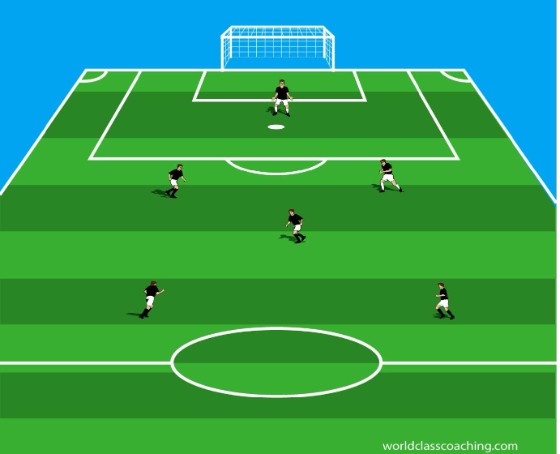
This system deploys a goalkeeper, two defenders, a midfielder and two forwards.
Key teaching points:
• All players should play each of the positions (including goalkeeper) at U9 and U10.
• Playing time should be equal or nearly equal for all players at this stage of their development.
• Teach the team to understand the various roles within the system.
• Forwards: Carry the attack and serve as outlet players in transition. Also apply defensive pressure to opposing backs. Teach them to use the midfielder for support.
Midfielder: Connecting player who supports underneath the forwards and works hard on both sides of the ball. In this arrangement, she typically plays centrally, allowing the forwards and defenders to work on the flanks. The midfielder should understand the concept of changing fields and also work with the defenders to deal with opponent attacks.
Defenders: One of the most common points of coaching that needs to be emphasized is the need to keep the defenders connected to play as the team moves forward (i.e. the defenders should get to mid-field when the ball is in the team’s attacking front third, and not remain in the back third with the goalkeeper). In addition, the defenders should learn early on the concept of covering their partner, which in essence is the idea that the defenders need to be staggered, with one player pressuring the ball and the other player stepping back to “cover” her partner in case the ball gets in behind. Defenders need to learn to be disciplined in this concept and also understand how their roles interchange depending on the situation. In transition, defenders should be taught to look for outlet passes to the forwards and also to the midfielder.
Goalkeeper: As this should be a rotating position at U9 and U10, the coach should focus on making sure the entire team understands safe handling and distribution of the ball and the rules of the game (i.e. when and where to pick up the ball). Safe diving, angle play, and dealing with break-aways and set-pieces are more advanced skills that may be taught to the team, particularly at U10.
Common points of concern:
• The most common issue here is the tendency of young players to bunch up. This is endemic to the age groups, undeveloped sense of tactical understanding and enthusiasm of the age. Coaches need to patient and persistent in encouraging players to develop a sense of tactical spacing. Many coaches use zone games, where players are confined to certain parts of the field, to enforce such spacing, and such restrictions have some value but should be applied only for a few minutes at a time in training, as the overriding concern here is the need to enhance players’ enjoyment of the game and boxing them off in grids is not supportive of this priority. A more useful and less limiting tactic is to employ “freeze” calls in the course of playing to show players a picture of the bunching occurring on the field. Then quickly move players to better spacing and restart play. Either way, this is one issue all coaches of young players encounter and patience is the key.
• No transition. Many young teams look very good in their attacking half and struggle to clear their own end once the ball arrives there. This is another characteristic that is endemic to U9-U10 soccer. Transition is difficult because players have difficulty playing the ball over distance (and with accuracy) and because team shapes do not often allow for predictable development of transition. Once again, the coach needs to be patient. Ball striking is one of the most under-developed skills in young American players, and if coaches devote considerable training time to this topic, it will be possible to develop players’ ability to play a longer pass (i.e. from the defenders to the forwards), which will aid in transition. Also, coaches can encourage the team to transition both directions together, which will increase the likelihood of winning the ball back on defense and providing support for the attack (another reason it’s difficult to sustain transition at this age). Finally, the coach can demonstrate passing patterns (i.e. from the defenders to the forwards) with the players on the field in their positions to familiarize players with the most useful passing and transition patterns.
• Players who do not want to play goalkeeper. This is a difficult situation many coaches face in trying to rotate players through the positions as the season progresses. While no player should be forced to play goalkeeper, all should be encouraged to try. Many coaches rotate goalkeepers at the half, making the time a young player will play in goal shorter (they get to play on the field for half of the game) and often more tolerable. It is also useful to work with parents to have them encourage their player try playing goalkeeper.
Systems of Play: 1-2-2-1
Teams at these age groups play with a goalkeeper and five field players. One of two common arrangements of players is 1-2-2-1 (1-2-1-2 is recommended). This chapter provides an overview of considerations for coaches to implement this system of play. It must be stressed at the outset, however, that tactical considerations at U9 and U10 are secondary to technical development and the idea here is to simply provide a framework for organizing the team.
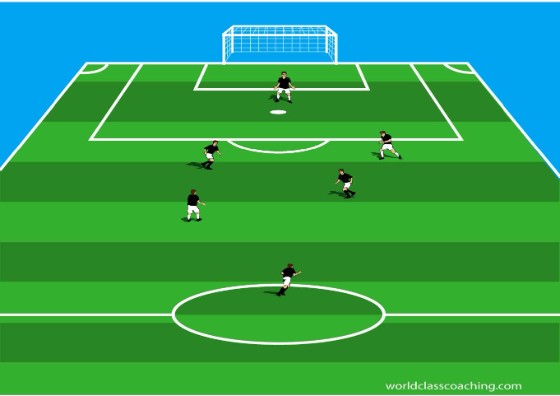
This system deploys a goalkeeper, two defenders, two midfielders and a single forward.
Key teaching points:
• All players should play each of the positions (including goalkeeper) at U9 and U10.
• Playing time should be equal or nearly equal for all players at this stage of their development.
• Teach the team to understand the various roles within the system.
Forward: Carry the attack and serve as an outlet player in transition. Also apply defensive pressure to opposing backs. Teach forward to use the midfielder for support. NOTE: In this system, it is useful to teach the forward to try to stay in line with the ball when it is in the defensive third of the field (this provides a long pass outlet for the backs in particular in transition).
Midfielders: Connecting players who supportsunderneath the forward and work hard on both sides of the ball. In this arrangement, they typically split the field and they should work to be available for one-another whenever the team is in possession. The midfielders should understand the concept of changing fields and also work with the defenders to deal with opponent attacks.
Defenders: One of the most common points of coaching that needs to be emphasized is the need to keep the defenders connected to play as the team moves forward (i.e. the defenders should get to mid-field when the ball is in the team’s attacking front third, and not remain in
the back third with the goalkeeper). In addition, the defenders should learn early on the concept of covering their partner, which in essence is the idea that the defenders need to be staggered, with one player pressuring the ball and the other player stepping back to “cover” her partner in case the ball gets in behind. Defenders need to learn to be disciplined in this concept and also understand how their roles interchange depending on the situation. In transition, defenders should be taught to look for outlet passes to the forwards and also to the midfielder.
Goalkeeper: As this should be a rotating position at U9 and U10, the coach should focus on making sure the entire team understands safe handling and distribution of the ball and the rules of the game (i.e. when and where to pick up the ball). Safe diving, angle play, and dealing with break-aways and set-pieces are more advanced skills that may be taught to the team, particularly at U10.
Common points of concern:
• The most common issue here is the tendency of young players to bunch up. This is endemic to the age groups, undeveloped sense of tactical understanding and enthusiasm of the age. Coaches need to patient and persistent in encouraging players to develop a sense of tactical spacing. Many coaches use zone games, where players are confined to certain parts of the field, to enforce such spacing, and such restrictions have some value but should be applied only for a few minutes at a time in training, as the overriding concern here is the need to enhance players’ enjoyment of the game and boxing them off in grids is not supportive of this priority. A more useful and less limiting tactic is to employ “freeze” calls in the course of playing to show players a picture of the bunching occurring on the field. Then quickly move players to better spacing and restart play. Either way, this is one issue all coaches of young players encounter and patience is the key.
• No transition: Many young teams look very good in their attacking half and struggle to clear their own end once the ball arrives there. This is another characteristic that is endemic to U9-U10 soccer. Transition is difficult because players have difficulty playing the ball over distance (and with accuracy) and because team shapes do not often allow for predictable development of transition. Once again, the coach needs to be patient. Ball striking is one of the most under-developed skills in young American players, and if coaches devote considerable training time to this topic, it will be possible to develop players’ ability to play a longer pass (i.e. from the defenders to the forwards), which will aid in transition. Also, coaches can encourage the team to transition both directions together, which will increase the likelihood of winning the ball back on defense and providing support for the attack (another reason it’s difficult to sustain transition at this age). Finally, the coach can demonstrate passing patterns (i.e. from the defenders to the forwards) with the players on the field in their positions to familiarize players with the most useful passing and transition patterns.
• Players who do not want to play goalkeeper. This is a difficult situation many coaches face in trying to rotate players through the positions as the season progresses. While no player should be forced to play goalkeeper, all should be encouraged to try. Many coaches rotate goalkeepers at the half, making the time a young player will play in goal shorter (they get to play on the field for half of the game) and often more tolerable. It is also useful to work with parents to have them encourage their player try playing goalkeeper.
• In this system, the single forward may not produce enough attacking. The coach should encourage both midfielders to push hard to get forward (attack with three players, not one).
• The defenders do not get forward. U9 and U10 teams often struggle because the backs stay deep in their own end of the field when the ball is in the attacking third. This is a critical point for the coach to address: All players participate in the attack and also in defense. The backs should get to the mid-line and be willing to step up and defend a bit, staying connected to the play at all times. This adjustment will both increase the team’s ability to win the ball in the attacking half (and sustain attacks), and also substantially increase the sense of importance (and fun) for playing defense in young players.
Set-Pieces at U9-U10
At U9-U10, players must be trained to respond to attacking and defending set-pieces including kick-offs, goal kicks, corner kicks, throw-ins and also indirect kicks (all fouls result in indirect free kicks at this age). The general advice here is to work hard as a coach to help players understand the rules of the game, referee signals and interpretations, and then give players general instructions and roles to be fulfilled. Complicated re-starts are not recommended at these ages. The best means of practicing set-piece restarts is to either train a handful of repetitions in isolation in training or to mix in artificial restarts in the game portion of training to familiarize players with their responsibilities.
Kick-off: Attacking
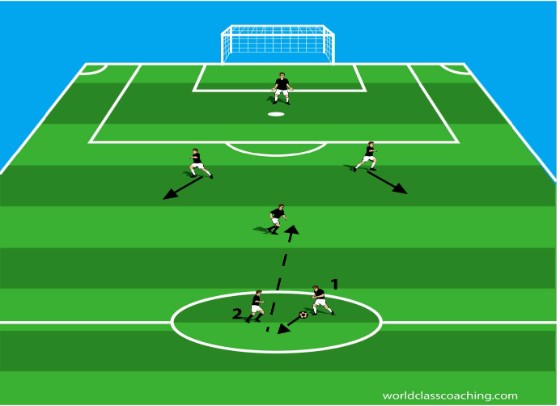
Player 1, a forward, taps the ball to player 2, the other forward (or a midfielder if the team plays a one-front). That player passes back to the central midfielder. Note that the defenders then work to get a bit wider in support of the midfielder in possession, while the attacker(s) work to create flank angles to play forward.
Variations:
• players 1 and 2 inter-pass, attacking the opposing goal immediately, while their teammates move forward in support.
• the ball is played early and hard into an attacking corner and the team moves forward in support.
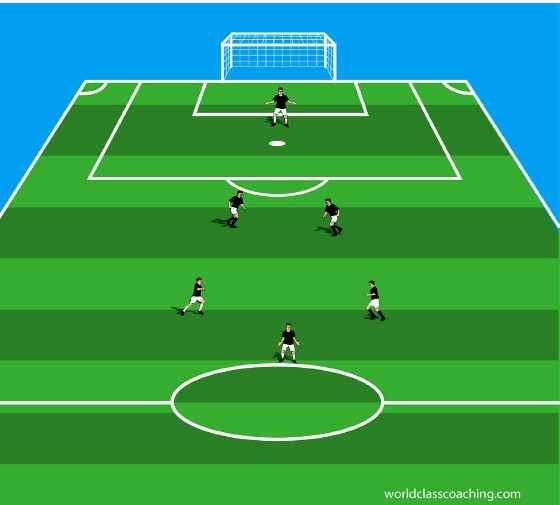
Kick-off: Defending
All players must be outside the center circle until the ball is played by the opposing team. Note that the shape of the defending team is centrally-concentrated, as the greatest danger is that the opposing team will make a quick run at goal. The attacker(s) should immediately press the ball when the ball becomes live.
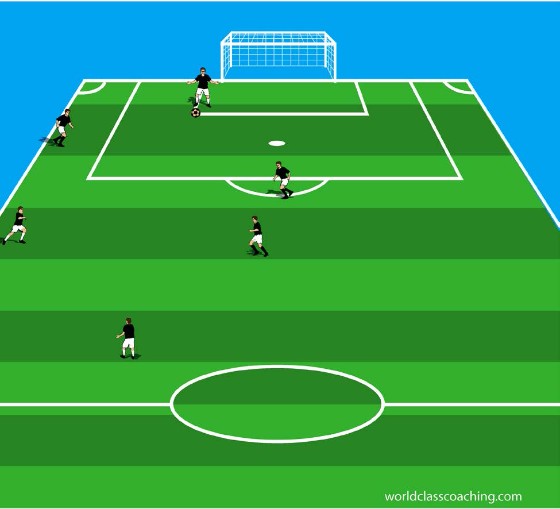
Goal kicks: Attacking
This is an often-overlooked aspect of attacking that can lead to very poor team transition if the group are unprepared to focus and react when the ball is put in play. Note the starting positions of the team in the diagram. The goalkeeper takes the kick, and then returns immediately to the goal. The near-side defender stretches to the flank as a short outlet. She must be instructed to pinch in immediately if she is not played so that the defenders are in good position to defend if the ball is lost.
The back-side defender is at the top of the box, ready to defend if the ball is lost (she is not a target on a goal kick, as playing her may lead to a loss of possession right in front of goal). The midfielder(s) move ball-side as well and if there are two midfielders, one stretches all of the way to the touch-line and is the primary target for the kick. If there is one midfielder, she gets in line with the ball. If there is one forward, she also gets in line or slightly outside of the ball. A second forward would be the target player for the kick and her starting position is along the touch-line as shown.
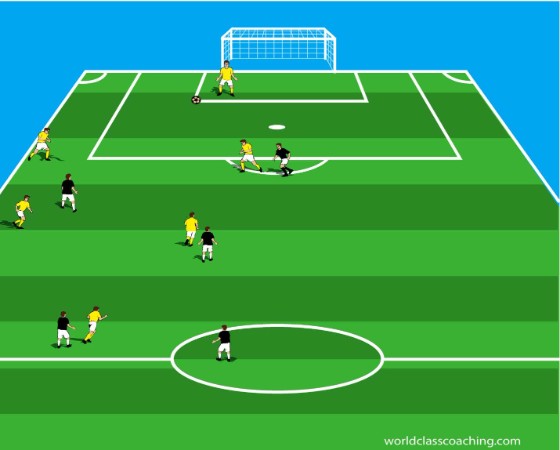
Goal kicks: Defending
Here, the team prepare to defend a goal kick by the opponents. Encourage players to mark the nearest opponent and to work to get the first touch on the ball once it is put in play. Many goals are scored out of this situation at these levels because the team taking the goal kick often fails to quickly condense their shape once the ball is put in play.
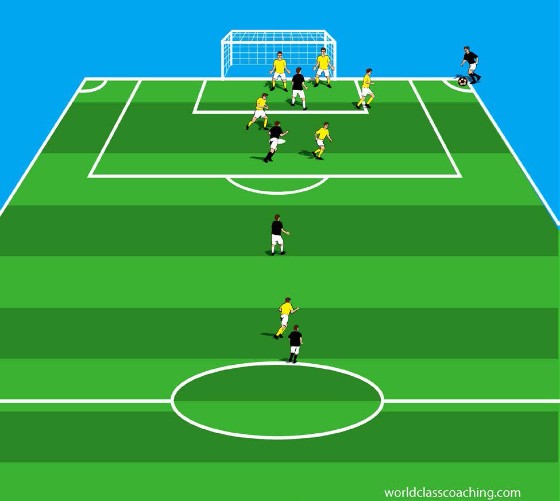
Corner kicks: Attacking
The attackers send one player to the corner for the restart. She sends the ball into the area for her teammates (note the run by the player at the back corner of the box, who serves as a target). Note also that one defender remains at mid field in case possession is lost and the other moves close to the top of the area to finish any ball that pops out. Finally, one of the attackers gets in tight to the goalkeeper, assuring that she cannot handle the ball off of the kick (the attacker cannot impede the goalkeeper’s movement but she can move to the ball and get the first touch, and her presence often causes rebounds or easy finishing opportunities when the ball drops in).
Variations:
• Two players go to the corner and they restart play through a short pass and then a serve toward the goal.
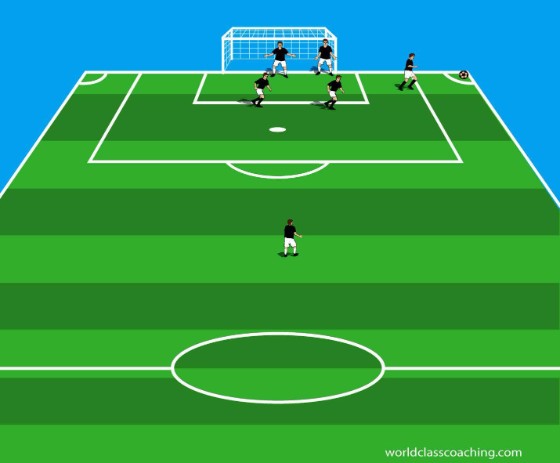
Corner kicks: Defending
Defending corner kicks at these ages presents an opportunity to teach the players about thinking about defending as a group. In the example above, a defender stands at the near post. Her responsibility is to send away any ball that is played directly into her space from the corner. The other defender marks the nearest opponent (goal-side) in the box area, and the midfielder(s) do the same. Note that a forward is sent to the corner to deal with any short corner attempt by the opposition and perhaps knock down any effort by the kicker to serve the ball before goal. The general notion here is to teach young players to want to get the first touch in this situation and for the group to work together to clear the ball and move forward as a team.
Throw-ins: Attacking
Young players often struggle to learn throw-in technique as they enter competitive play. Coaches should mix in throw-in practice in isolation at training and also in inter-squad scrimmages at training, checking in particular to see that players know to keep their back heel on the ground and that they bring the ball back over their head before extending their arms forward on the follow-through. Tactically, the two most critical pieces of advice are to:
• throw the ball forward (lots of counter-attacks arise from backward throw-ins on the small field).
• throw the ball to the feet of the target.
Target players should get ahead of the ball and work to get the first touch on the ball.
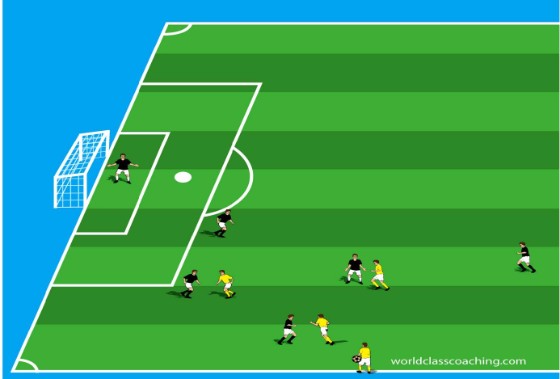
Throw-ins: Defending
Players at this age defending throw-ins should focus on:
• getting goal-side (all players in the front half of the field and all but the forward(s) in the back half.
• marking the most likely target players.
• trying to get the first touch on the ball.
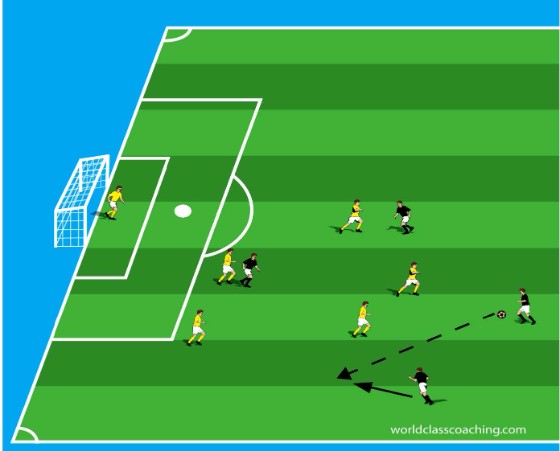
Indirect free kicks: Attacking
Free kicks can take place across the field and generally if they occur in the back half of the field, it is best to just restart with a short pass to a teammate. In the front half of the field, if the team is able to serve a ball at goal, it is useful to practice either a run-over with a touch (the ball must move) or a short pass of the ball to set up the serve. At least one other player should make a run at goal to try to put away any rebound.
Variations:
• pass a ball into a corner for a runner to cross toward goal.
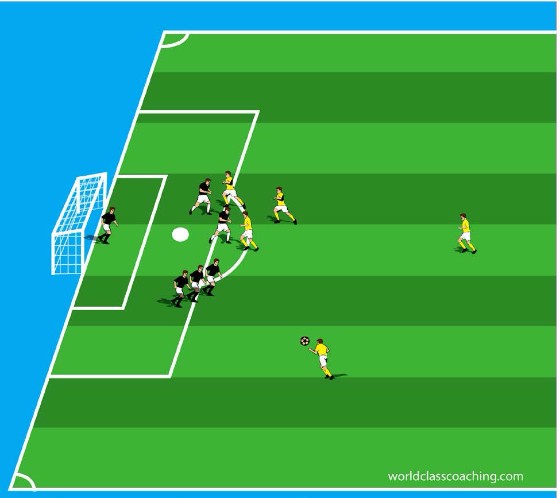
Indirect free kicks: Defending
The spot of the restart affects the team’s response. In the attacking half of the field, the team all get goal-side and mark opponents. In the defending half, if a shot is a possibility, 2-3 players form a wall (based on the near post) and the goalkeeper marks the back half of the goal. The other players mark the opposing players nearest the goal.


